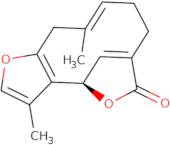Linderalactone
CAS: 728-61-0
Rif. 3D-FL146842
| 1mg | Fuori produzione | ||
| 2mg | Fuori produzione | ||
| 5mg | Fuori produzione | ||
| 250µg | Fuori produzione | ||
| 500µg | Fuori produzione |
Informazioni sul prodotto
- (4R)-3,11-dimethyl-4,8,9,12-tetrahydro-4,7-(metheno)furo[3,2-c]oxacycloundecin-6-one
- (4R,10E)-4,8,9,12-Tetrahydro-3,11-dimethyl-6H-4,7-methenofuro[3,2-c]oxacycloundecin-6-one
- (R,10E)-4,8,9,12-Tetrahydro-3,11-Dimethyl-6H-4,7-Methenofuro[3,2-C]Oxacycloundecin-6-One
- 6H-4,7-Methenofuro(3,2-c)oxacycloundecin-6-one, 4,8,9,12-tetrahydro-3,11-dimethyl-, (4R,10E)-
- 6H-4,7-Methenofuro(3,2-c)oxacycloundecin-6-one, 4,8,9,12-tetrahydro-3,11-dimethyl-, (R-(E))-
- Germacra-1(10),4,7,11-tetraen-15-oic acid, 8,12-epoxy-6alpha-hydroxy-, gamma-lactone, (E)-( )-
- Germacra-1(10),4,7,11-tetraen-15-oic acid, 8,12-epoxy-6α-hydroxy-, γ-lactone, (E)-(+)-
Linderalactone is a sesquiterpene lactone that inhibits the cell cycle and induces apoptosis. It inhibits the expression of p21, which is an inhibitor of cyclin-dependent kinases and is involved in the regulation of cell proliferation. Linderalactone also inhibits the mitochondrial membrane potential, leading to cell lysis and death. This compound has been shown to have inhibitory properties against colon cancer cells in culture, as well as to induce apoptosis in malignant brain cells. The mechanism by which this compound induces apoptosis may be caspase-independent cell death.





